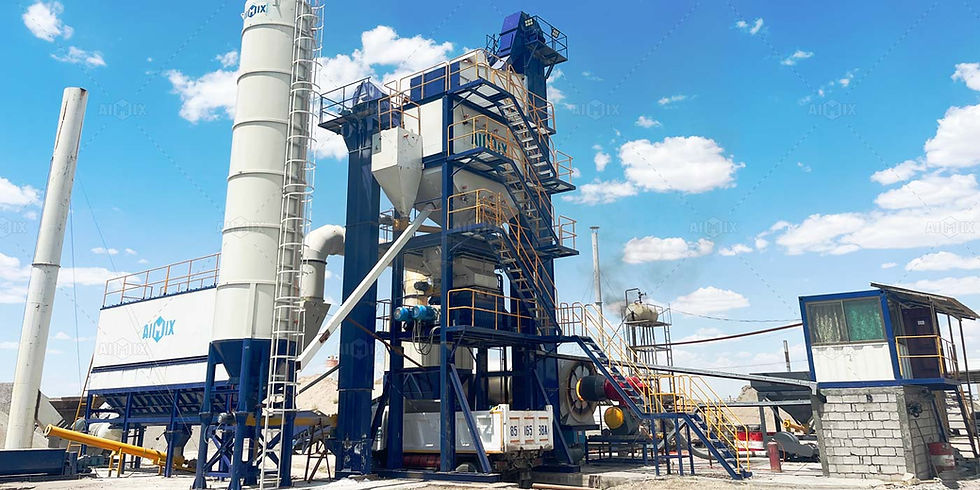How Many Loads Per Hour Are Required to Support Continuous Paving with 80 TPH Asphalt Plant Output?
- aimixglobal5
- Jul 29, 2025
- 3 min read
When planning a road construction project, efficiency in asphalt delivery is critical. If you're using an 80 TPH asphalt mixer plant, understanding how many truckloads per hour are needed to ensure uninterrupted paving is essential. In this article, we’ll break down the calculation, explain influencing factors, and offer practical insights from the contractor’s point of view. Whether you're working on a rural road or a multi-lane urban highway, getting this right means fewer delays and better quality asphalt finishes.

Why Load Planning Matters for Continuous Paving
In road construction, consistency is key. A lapse in hot mix delivery can cool down the paving surface and cause compaction issues. That’s why proper coordination between asphalt production and transportation is non-negotiable.
To support continuous paving, you need to ensure your haul trucks arrive just in time, neither too early nor too late. Too few trucks? Paver stops. Too many? Asphalt sits and cools. This article shows you how to strike the right balance.
Basic Calculation: Loads Per Hour for 80 TPH Asphalt Plant
An 80-ton-per-hour (TPH) amp aspal mixing plant produces 80 tons of asphalt every hour. To keep paving non-stop, you must match this output with timely truck deliveries.
Step 1: Estimate Truck Capacity
Most dump trucks in Southeast Asia and similar markets carry between 15 to 20 tons per load. Let’s assume an average capacity of 16 tons per load.
Step 2: Divide Plant Output by Truckload Size
80 TPH ÷ 16 tons/load = 5 truckloads per hour
This means your site needs 5 trucks unloading asphalt every hour to match the 80 TPH plant output. But in practice, it’s not just about the number. You also need to factor in round-trip time and unloading speed.

Real-World Factors That Affect Load Frequency
After calculating the base number of truckloads, you need to consider real-world conditions. These can significantly affect how many trucks are truly needed on the road.
1. Haul Distance and Road Conditions
If your jobsite is 10 km away from the asphalt plant, round-trip times will vary based on road surface, traffic, and gradient. A longer haul means fewer trips per truck per hour, so you need more trucks to maintain the delivery pace.
2. Truck Unloading and Paver Speed
The paver must lay asphalt at a steady pace. If unloading takes too long, the paver might have to stop. Ensure your trucks have hydraulic tailgates and the right angle for fast discharge.
3. Asphalt Temperature Loss
Asphalt starts cooling the moment it leaves the drum. Too long in transit or waiting, and it's below compaction temperature. This results in poor pavement bonding and shortens road lifespan.
Therefore, beyond numbers, you also need insulated or covered trucks, especially in cold or rainy areas like parts of Sumatra or Papua Highlands.
How Many Trucks Do You Really Need?
If one truck can only make two round-trips per hour due to traffic or long hauls, then you need at least 3 trucks per 2 trips = 6 trucks per hour to deliver 80 tons. Always build in a buffer — adding 10–15% more trucks than the base number is a good practice.
In short, for an 80 TPH plant, you often need 6 to 8 trucks operating simultaneously, depending on distance and discharge speed. This ensures a steady material flow and prevents the paver from idle time.

Project Examples and Use Cases
Here are two sample cases from real contractors we’ve supported:
Urban Highway (4-lane, 12 km): Short haul distance of 4 km, 80 TPH output, used 5 trucks rotating every 25 minutes. Paving completed in 3 working days.
Rural Road in Kalimantan (25 km total): Longer haul, required 8 trucks rotating every 40 minutes. Used insulated beds to retain heat during rain season.
In both cases, maintaining 80 TPH required tight coordination between mixing, transport, and paving teams.
Final Thoughts: Match Output with Logistics for Paving Success
Knowing your hot asphalt mixing plant's hourly output is only half the story. The real challenge lies in synchronizing plant productivity with truck availability and on-site paving speed. For an 80 TPH plant, delivering at least 5 to 6 loads per hour under typical site conditions is the baseline. But to ensure quality, especially over long hauls or in challenging terrain, it's wise to overestimate slightly.

Need Help Optimizing Your Asphalt Paving Logistics?
At AIMIX, we not only supply reliable 80 TPH mobile and stationary asphalt mixing plants but also help clients calculate truck requirements and plan real-world workflows. With years of field experience across Indonesia and Southeast Asia, our team can help you reduce material waste, improve paving quality, and complete projects on time.
Need a complete asphalt mixing and transport solution? Contact us today. Let’s optimize your next paving project from plant to paver.







Comments